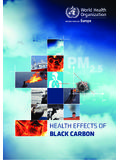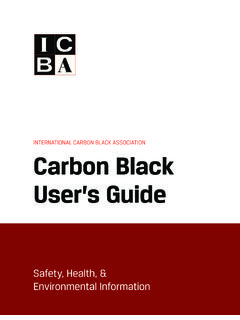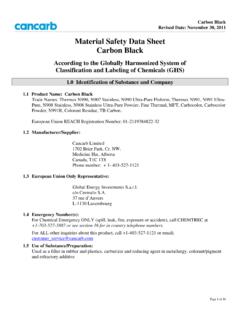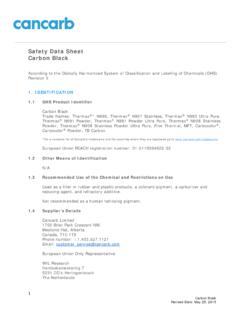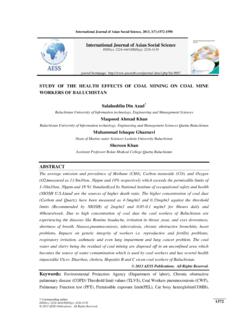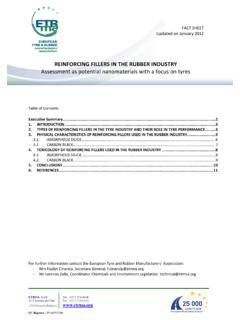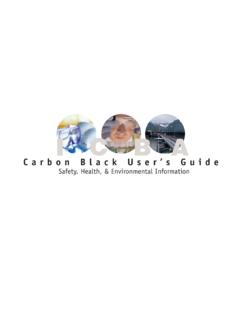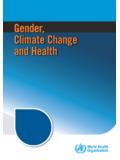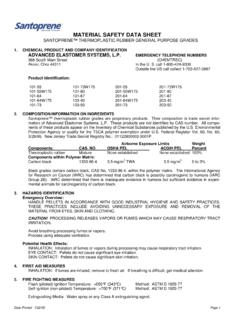Transcription of Health effects of particulate matter final (Eng)
1 Health effects Policy implications for countries in eastern Europe, of particulate matter Caucasus and central Asia Abstract This paper summarizes the evidence about the Health effects of air pollution from particulate matter and their implications for policy-makers, with the aim of stimulating the development of more effective strategies to reduce air pollution and its Health effects in the countries of eastern Europe, the Caucasus and central Asia. Keywords AIR POLLUTION - adverse effects ENVIRONMENT AND PUBLIC Health . ENVIRONMENTAL POLLUTANTS. Health POLICY. particulate matter - analysis POLICY MAKING. Address requests about publications of the WHO Regional Office for Europe to: Publications WHO Regional Office for Europe UN City, Marmorvej 51.
2 DK-2100 Copenhagen , Denmark Alternatively, complete an online request form for documentation, Health information, or for permission to quote or translate, on the Regional Office web site ( ). ISBN 978 92 890 0001 7. World Health Organization 2013. All rights reserved. The Regional Office for Europe of the World Health Organization welcomes requests for permission to reproduce or translate its publications, in part or in full. The designations employed and the presentation of the material in this publication do not imply the expression of any opinion whatsoever on the part of the World Health Organization concerning the legal status of any country, territory, city or area or of its authorities, or concerning the delimitation of its frontiers or boundaries.
3 Dotted lines on maps represent approximate border lines for which there may not yet be full agreement. The mention of specific companies or of certain manufacturers' products does not imply that they are endorsed or recommended by the World Health Organization in preference to others of a similar nature that are not mentioned. Errors and omissions excepted, the names of proprietary products are distinguished by initial capital letters. All reasonable precautions have been taken by the World Health Organization to verify the information contained in this publication. However, the published material is being distributed without warranty of any kind, either express or implied. The responsibility for the interpretation and use of the material lies with the reader.
4 In no event shall the World Health Organization be liable for damages arising from its use. The views expressed by authors, editors, or expert groups do not necessarily represent the decisions or the stated policy of the World Health Organization. Cover photo: gnubier - Contents Acknowledgements .. II. Abbreviations .. II. Introduction and context .. 2. What is particulate matter ? .. 2. Where does PM come from? .. 3. What are the levels of and trends in PM in the WHO European Region ? .. 4. What are the Health effects of PM? .. 6. What is the burden of disease related to exposure to PM? .. 7. WHO AQGs .. 8. Evidence on effects of air quality improvements .. 9. Follow-up to the Harvard Six Cities Study, United States.
5 9. Short-term decrease in industrial emissions, United States .. 9. Respiratory Health studies and air pollution abatement measures, Switzerland .. 10. Air quality management and policy .. 11. Conclusions .. 12. References .. 13. Acknowledgements This publication was prepared by the Joint WHO/Convention Task Force on Health Aspects of Air Pollution according to the Memorandum of Understanding between the United Nations Economic Commission for Europe and the WHO Regional Office for Europe. The Regional Office thanks the Swiss Federal Office for the Environment for its financial support of the work of the Task Force. The Task Force on Health work is coordinated by the WHO Regional Office's European Centre for Environment and Health , Bonn.
6 Convention on Long-Range Transboundary Air Pollution Abbreviations AQG air quality guidelines EECCA eastern Europe, the Caucasus and central Asia PAH polycyclic aromatic hydrocarbon PM particulate matter UNECE United Nations Economic Commission for Europe II. III. Introduction and context In most countries in the region covered by the United Nations Economic Commission for Europe (UNECE), ambient air quality has improved considerably in the last few decades. This has been achieved by a range of measures to reduce harmful air emissions, including those stipulated by the various protocols under the Convention on Long-range Transboundary Air Pollution (1). There is, however, convincing evidence that current levels of air pollution still pose a considerable risk to the environment and to human Health .
7 Recently, the Executive Body of the Convention has adopted amendments to the Convention's 1999 Gothenburg Protocol to Abate Acidification, Eutrophication and Ground- level Ozone. Following years of negotiations, the approved revised text of the Protocol now specifies national emission reduction commitments for main air pollutants to be achieved by the UNECE Parties by 2020 and beyond. The revised Protocol includes, for the first time, commitments to reduce the emission of fine particulate matter ( ). Furthermore, black carbon or soot is now included in the revision as an important component of Black carbon is an air pollutant which both affects Health and contributes to climate change (2). What is particulate matter ?
8 PM is a widespread air pollutant, consisting of a mixture of solid and liquid particles suspended in the air. Commonly used indicators describing PM that are relevant to Health refer to the mass concentration of particles with a diameter of less than 10 m (PM10) and of particles with a diameter of less than m ( ). , often called fine PM, also comprises ultrafine particles having a diameter of less than m. In most locations in Europe, constitutes 50 70% of PM10. PM between m and 1 m in diameter can remain in the atmosphere for days or weeks and thus be subject to long-range transboundary transport in the air. PM is a mixture with physical and chemical characteristics varying by location. Common chemical constituents of PM include sulfates, nitrates, ammonium, other inorganic ions such as ions of sodium, potassium, calcium, magnesium and chloride, organic and elemental carbon, crustal material, particle-bound water, metals (including cadmium, copper, nickel, vanadium and zinc) and polycyclic aromatic hydrocarbons (PAH).
9 In addition, biological components such as allergens and microbial compounds are found in PM. 2. Where does PM come from? Particles can either be directly emitted into the air (primary PM) or be formed in the atmosphere from gaseous precursors such as sulfur dioxide, oxides of nitrogen, ammonia and non-methane volatile organic compounds (secondary particles). Primary PM and the precursor gases can have both man-made (anthropogenic) and natural (non-anthropogenic) sources. Anthropogenic sources include combustion engines (both diesel and petrol), solid-fuel (coal, lignite, heavy oil and biomass) combustion for energy production in households and industry, other industrial activities (building, mining, manufacture of cement, ceramic and bricks, and smelting), and erosion of the pavement by road traffic and abrasion of brakes and tyres.
10 Agriculture is the main source of ammonium. Secondary particles are formed in the air through chemical reactions of gaseous pollutants. They are products of atmospheric transformation of nitrogen oxides (mainly emitted by traffic and some industrial processes) and sulfur dioxide resulting from the combustion of sulfur-containing fuels. Secondary particles are mostly found in fine PM. Soil and dust re-suspension is also a contributing source of PM, particularly in arid areas or during episodes of long-range transport of dust, for example from the Sahara to southern Europe. Photo: Martina B hner - 3. What are the levels of and trends in PM. in the WHO European Region1 ? The WHO Environment and Health Information System (ENHIS), which is based to a large extent on data submitted by European Union (EU) member states to the European Environment Agency AirBase (3), includes PM10 monitoring data from urban and suburban background locations.










